Today’s pic comes from Ok Housecat on Facebook.
This effect makes your music smell like cat litter
🆗
🏠
🐈
Please visit their page for more custom-electronics fun 😺

Today’s pic comes from Ok Housecat on Facebook.
This effect makes your music smell like cat litter
🆗
🏠
🐈
Please visit their page for more custom-electronics fun 😺
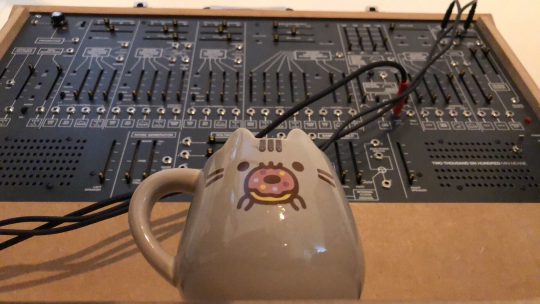
Cat mug with a TTSH, a clone of the Arp 2600 synthesizer. By Alexander Henriksson on Facebook.
And another cat has found its
🏠
The TTSH is an Arp 2600 clone that can be built as a DIY project, as described by The Human Comparator. San Pedro Labs builds full versions, including wood casings. (They used to be here in San Francisco, but have recently relocated to New Mexico.)
Charlotte the cat contemplates the horror that is a circuit-bent Big Mouth Billy Bass. From Ok Housecat on YouTube.
I was often sardonically amused by this fishy contraption since the commercials in the 1990s. But now I am genuinely intrigued by its circuit-bending possibilities. At the very least, it could make for a fun CatSynth TV episode. I found at least one set of instructions here, but it might be even more fun to just take it aport and just explore with alligator cables.
The Horror…The Horror…
From Ok Housecat. Visit their website okhousecat.com, where you can see an amazing array of circuit-bent and other custom electronic instruments. We at CatSynth are going to spend some more time exploring the video demos 😻
We are always on the lookout for something (or someone) different at NAMM, especially in the deep dark depth of Hall E. This year we found it in the booth of Yudo, a company out of Japan that presented prototypes for two radically different concepts.
The flagship Neuman synthesizer features a standard keyboard with an instrument-spanning touch screen. It looks like an iPad stretched out to fit a full-sized keyboard.
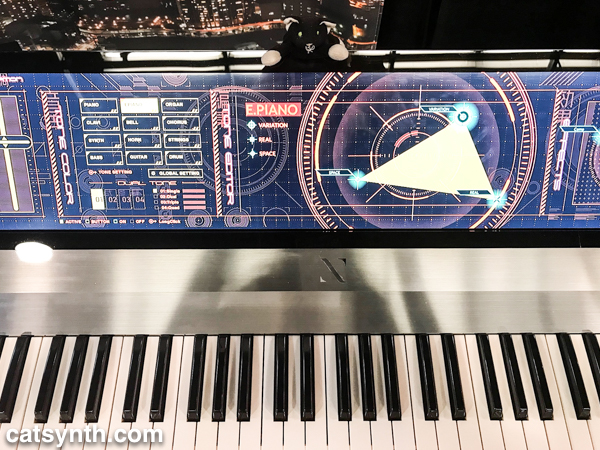
The keyboard plays well, and there were standard sounds such as electric pianos, brass, etc. The touchscreen controls for the patches were fascinating, but not particularly intuitive. It was hard to see using it for sound design in its current incarnation. But it is a prototype with an estimated two years or more of development ahead, so we will see where things go.
At the opposite end of the spectrum is the KAMI-OTO, a small cardboard based keyboard controller to use with iPads. It is a simple cardboard cutout that folds around a simple electronic main board and includes a stand for your tablet. There are wired and Bluetooth models that go for $28 and $36, respectively via the company’s Kickstarter campaign.
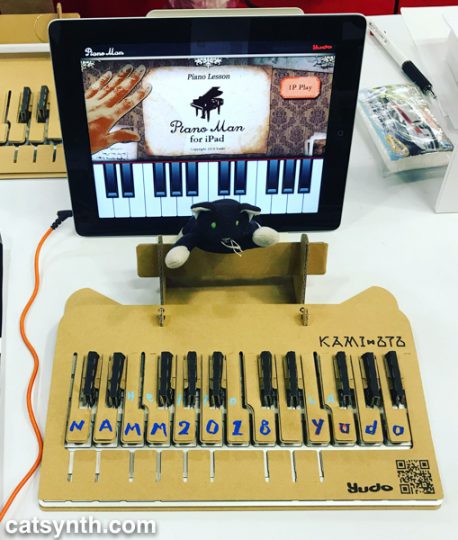
We did have a chance to try it out. It is adorable, and it does look like a fun and simple DIY project to assemble. And there is some delight in being able to decorate it in whatever manner one desires. As a keyboard, however, the latency was extremely high, which would render it less than usable for us in a performance setting. Nonetheless, for composing on the run, it could come in handy.
More info about both products can be found at https://www.yudo.jp/en/.
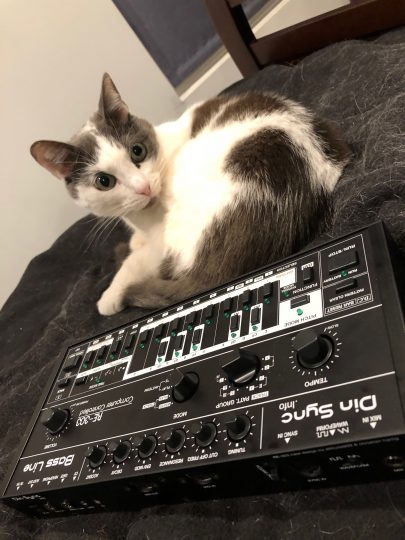
Our pal Mister Kitty returns to the pages of CatSynth with his new RE-303 bass synthesizer.
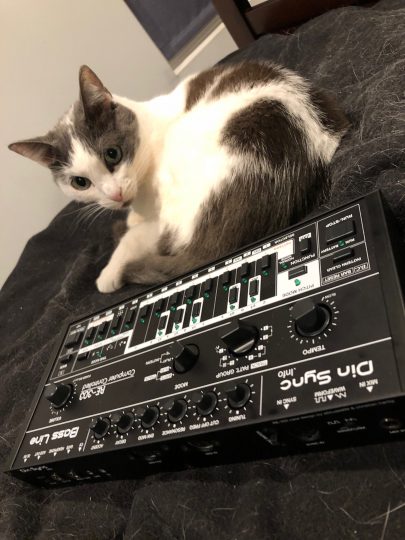
The RE-303 is a replica of the infamous Roland TB-303. This one was assembled by Mister Kitty’s human, Prophei (aka Michael Dietel). We at CatSynth approve of their choice of the black case. Oh, and it sounds great, too.
As a replica, the circuit board and CPU are compatible with the original TB-303, which suggests the parts can be used to refurbish vintage instruments in addition to building new ones. You can read a bit more in this Synthopia article from 2015. Clearly, the statement about DIY kits turned out to be wrong, as evidenced by this article. You can find out more about the RE-303 and kits here.

Meanwhile, we wonder what Mister Kitty may have in store for us next…

Meet Zelda the Grey British Blue, who approves of the studio updates that include painted 1U panels, a microKORG, Roland rhythm box, and intriguing little DIY synth in an Altoids box, and more. From skaterdays on Instagram.
The 2017 Outsound New Music Summit kicked off this Sunday with the annual Touch the Gear event. As always, there were several musicians and instrument-makers were on hand to demonstrate their setups or inventions.

Above we see Alphastare demonstrating his setup for processing of synthesized and recorded sounds that he uses in his live shows. Below, CDP bandmate Tom Djll shows his analog modular synthesizer setup with sundry external boxes for expressive control of sound.

I opted to show my modular synth as well this year, along with the Moog Theremini.

The theremin is always a popular item at this event.
Kim Nucci demonstrated some custom modules alongside a Korg MS-20 mini and a DIY metal instrument with sensors.

I have always found metal plus electronics a musically interesting combination.
Among the more unusual and surprising instruments this year was Dania Luck’s musical chessboard. It contained sensors for the magnetic chess pieces, with each square of the board triggering a different synthesizer in a SuperCollider patch.

This wasn’t the only SuperCollider program being shown, as our friend Tim Walters demonstrated his patch and controller setup. It is the setup he will use as part of Usufruct in the opening concert for the Summit.

Tim Thompson was on hand with the latest incarnation of his electronic-music instrument, the Space Palette Pro.

[Tim Thompson demonstrates the Space Palette Pro to Outsound director Rent Romus.]
It uses the same software as previous versions of the Space Palette, but with a new more compact interface based on new touch-sensitive pads from Sensel Morph. These pads are quite impressive in both response and feel, and we at CatSynth will definitely be looking into them.
Not all the demos included electronics. There were several acoustic instruments demonstrated by the Pet the Tiger collective (David Samas, Ian Saxton, Tom Nunn, Derek Drudge), including this beautiful kalimba tuned to 31edo.

I would love to write a piece for it one of these days. There was also a large metalophone with a deep resonant tone, interesting tuning, and some satellite “bass” notes.

Back inside the hall, Motoko Honda demonstrated a network of electronic devices processing voice, along with a fun circuit-bent instrument.

Matt Davignon brought his setup for expressive manipulation and processing of samples and other pre-recorded sound materials.

We would also like to thank Matt for his efforts organizing this event every year! We would also like to thank the folks at VAMP for co-presenting and bringing a pop-up shop of records and sundry vintage and musical items.
It was a fun afternoon as always, and it was great to see families in attendance. And there were multiple things to inspire me musically and technologically. We will see where that goes. Next up, the concerts…
The monthy Church of the Superserge event at Robotspeak in San Francisco has been going on five years. We at CatSynth were on hand to mark this milestone during the May show.
Musically, the highlight was a solo set by Tom Djll on modular synth and mini trumpet. It was quite musical, blending rhythms and phrases with the timbral elements, even a “melody” of sorts from the processed trumpet.

The afternoon opened with a set by Normalien, also on modular synthesizer. Some delightfully weird sounds with rhythmic elements.

And Carson Day closed things out with a forceful set that included Novation and Dave Smith instruments.

It’s always a fun afternoon at Robotspeak. Not only do I enjoy the music and technology in the performances, but also just browsing the display cases on the wall, seeing what instruments I should covet next. This little DIY synth stood out this time, especially juxtaposed between the giant vacuum tube and the WMD pedal.

We look forward to next time, and perhaps playing again soon.
From brassmonkey on YouTube. Also featured on matrixsynth.
We caught up with Robert Jordan aka Cat Full of Ghosts in another of our Featured Artist Series interviews who is performing at our next Resonant show on the 7th May 2017 in Melbourne, Australia.
Yesterday we at CatSynth attended our local March for Science, part of a nationwide – and indeed, international – network of marches protesting the continued devaluing of science and reason in our public discourse and policy-making. From the March for Science Mission Statement
The March for Science champions robustly funded and publicly communicated science as a pillar of human freedom and prosperity. We unite as a diverse, nonpartisan group to call for science that upholds the common good and for political leaders and policy makers to enact evidence based policies in the public interest
People who value science have remained silent for far too long in the face of policies that ignore scientific evidence and endanger both human life and the future of our world. New policies threaten to further restrict scientists’ ability to research and communicate their findings. We face a possible future where people not only ignore scientific evidence, but seek to eliminate it entirely. Staying silent is a luxury that we can no longer afford. We must stand together and support science.
And indeed, a great many people gathered here in San Francisco to stand up for science, as can be seen in this picture, courtesy of the March for Science Facebook page.

The overhead view shows the march heading southwest on Market Street. At ground level, the march was characterized less by the density and size of the crowd, but its clever signs. To be sure, there were appropriate denunciations of Trump that would lead many to question the “nonpartisan” nature of the event, but more were just fun, smart, perhaps a bit snarky. All of which is awesome.

I must also say this was probably among the quietest of marches I have attended. Polite, perhaps even a bit introverted if a march can be described that way. There is no doubt the passion of many of the folks participating, but we do tend to be a quieter, more cerebral bunch. It lacked the exuberance of the annual Pride Parade, or even the loud vocal indignation of the Occupy protests in 2011 and 2012. For me personally, the most important message was “I can’t believe we actually are out here marching for this.” For a long time, science was well respected in public discourse (even if scientists themselves were sometimes teased). There has long been an anti-intellectual streak in American politics and discourse, but it has come to a new and dangerous level with the outright scorn and erasure of science by the angry populist movement that sees in Trump, a man proud of his own scientific illiteracy, a champion. This long predated any one person, but it’s long past time to stand up. Even nerds in lab coats have to get political in this climate.

If there was one thing that particularly bothered me about the crowd, it the relatively low representation of people of color. The lack of diversity in science, engineering and related fields is a topic of ongoing discussion. But it did make me feel a bit alienated politically and socially from the older, whiter, somewhat hippie-ish elements of crowd.
The march ended with a “science fair” in front of City Hall. It was pretty much a normal street fair, but the booths had a scientific theme to them. I was happy to see Mission Science Workshop, an organization dedicate to bringing both understanding and joy of science to one of our diverse local neighborhoods. I also saw the both of Association of Women in Science. I have to admit I quite like their hashtag/motto.

There was also a group of artists who do scientific illustrations. Among them was this pamphlet on circuit bending. I’m glad to see circuit bending making its way into the world of science education 😺

I did not stay long at the fair. It is not really my thing, especially on a cold and blustery day, and I had things to prepare for that evening. I am glad to have participated in the march, but the real questions will be what comes next.